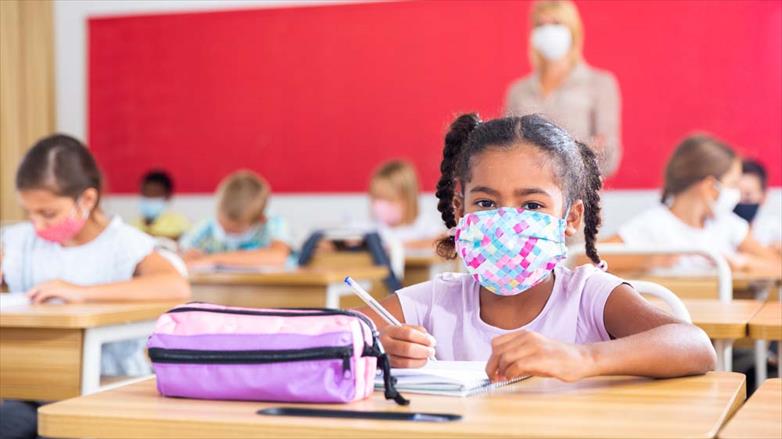
Calming Back to School Jitters:

As the days draw a bit shorter, the end of summer marks the beginning of a new school year. Children prepare by picking out their new backpacks and wait in anticipation for their room assignments, all while soaking up the last of the summer sun. As parents, we want to send our children out into the new school year feeling prepared, confident, and excited. However, we enter this new school year bringing with us the experiences of managing life during a global pandemic. The changes in routines, family life, and ongoing pandemic continue to affect us all. Your child may be more nervous, anxious, fearful, or unsure compared to years past. Here are 4 ways to help with the new school year jitters.
Talk to your child:
Start by talking with your child! I know it sounds simple – but it takes purpose and planning to set the time aside and initiate the conversation. Research has shown us that children and youth who discussed the pandemic with their parents were less likely to develop stress, depression, and anxiety symptoms. Many parents try to shelter children from current events, but we know that providing measured and purposeful information helps reduce anxiety. Additionally, children often do not talk about their concerns because of confusion or fear of worrying their loved ones. Encourage them to verbalize their thoughts and feelings about the new school year and let their questions guide you. It’s important to remember that how we discuss COVID can increase or decrease our children’s’ fears. Don’t avoid giving them information that experts say is crucial to their well-being and staying healthy. You should answer your children truthfully and help them develop their expectations for the school year, routines (e.g., masks or no masks, seating at lunch, what will happen at their school if someone gets sick). However, leave out unnecessary details and unknown factors. It’s also ok to say, ‘I don’t know, but we will work together to figure it out.’ This is a great opportunity for modeling calm in the face of ambiguity, as well as collaborative problem solving. You can be a good listener while providing the love and reassurance your child needs.
During unpredictable times, foster a sense of control:
Before the pandemic, schools were a source of consistency in our children’s lives. For most families, the 20/21 school year included constant changes which disrupted our daily schedules for months on end. Keeping your child on a regular schedule provides a sense of control, calm, well-being, and predictability. We can foster our children’s sense of control this fall by structuring schedules and expectations. First, think about your fall schedule and work with your child to make a daily or weekly calendar. Use blocks of color to represent places of activities to make it as visual as possible. You may think this would only benefit younger children, but we find it very effective with high schoolers and even college aged ‘kids’. You may also build concrete expectations to help your children foster a sense of control in their world. Your children may fear getting sick, quarantining, switching to online learning, or closures. Using language appropriate for their developmental level, describe their school’s new policies and procedures so they feel prepared for structured changes. Be clear about your household and school’s expectations regarding what your child will be doing to prevent COVID spread and infection. Remind them about hand washing and other safety precautions – these efforts to mitigate spread might seem so simple, but they work! Lastly, sit down together and make a list of what is in their control during their day. When children are able to identify what they are in control of, they feel calmer and more confident!
Fight anxieties with activities:
Since the onset of the pandemic, children have increased their screen time and sedentary behaviors. They are sitting more than they ever have before! Engagement in physical activity is particularly important to help reduce anxiety during stressful periods. Research tells us that youth who regularly engage in physical activity report less stress and have an easier time regulating their moods. As kids resume in person school this fall, provide a physical outlet for their difficult feelings. It can take the form of sports teams, walks around the neighborhood, silly obstacle courses in the yard or living room, or simply tossing a ball around. It doesn’t matter how your child chooses to move, as long as they move!
Stay vigilant and know the signs:
Most youth will manage the transition well with the support of their family, even if they show some symptoms of anxiety. Some youth may be at greater risk of developing mental health challenges and will need more support. If you notice your child has exhibited significant changes in behavior or any of the difficulties listed below, please reach out for more support. Research indicates that kids who receive supports earlier tend to recovery faster and have more stable gains in treatment. Also, if you want general support in providing your child with the skills to succeed and thrive during these extraordinary times, don’t hesitate to reach out. Emotional intelligence and regulation is one of the greatest predictors of positive child outcomes. It’s always a good idea to support mental wellness throughout a child’s development.
Clues that more support is needed:
Elementary Age Children– irritability, aggressiveness, clinginess, nightmares or other sleep disruption, school avoidance, poor concentration, stomach issues/headaches/body aches and pains, and withdrawal from activities and friends.
Adolescents– sleep and eating disturbances, agitation or irritability, increase in conflicts, physical complaints, social withdrawal, poor concentration, and rule breaking/oppositional behavior.
Together we can provide the skills and supports our kids and teens need to feel healthy and confident during these extraordinary times.

Recent Comments